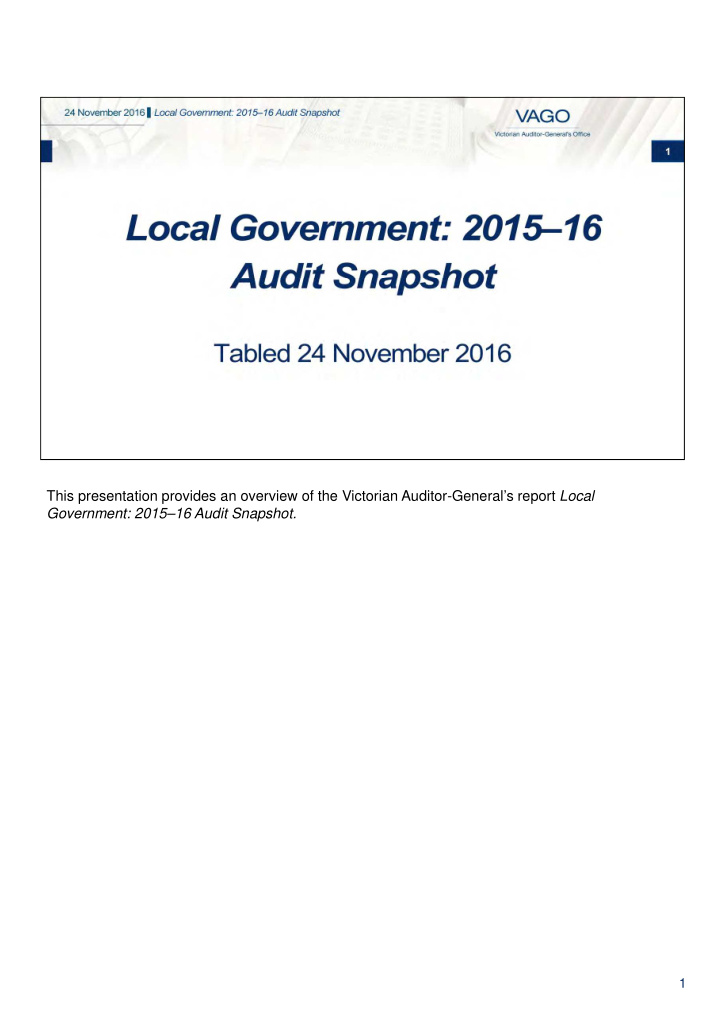



This presentation provides an overview of the Victorian Auditor-General’s report Local Government: 2015–16 Audit Snapshot. 1
Victoria’s constitution recognises local government as the third tier of government. It comprises 79 councils, 11 regional library corporations and 14 associated entities. In this report, the local government sector refers to the 79 councils. We have classified councils into five cohorts based broadly on size, demographics and funding, and this is consistent with the classification used by Local Government Victoria. There are 22 metropolitan councils, nine interface councils (those that form a ring around metropolitan Melbourne), 10 regional city councils, 19 large shire councils and 19 small shire councils. 2
In this report, we looked at matters arising from the 2015–16 financial and performance report audits of the local government sector and assessed its financial performance during 2015–16 and its financial sustainability as at 30 June 2016. We also looked at councils’ asset valuation framework. 3
All 79 councils received clear audit opinions for the 2015–16 financial and performance statements. We reviewed the internal control framework of each council as part of our financial audits. Across the councils we reported on 211 new internal control weaknesses that require attention. Councils have not taken remedial action to rectify similar issues we raised in prior audits—45 per cent of these issues have not been resolved at 30 June 2016. If not rectified, these weaknesses could result in material frauds or errors going undetected. They need to be resolved in a more timely way. 4
Collectively the local government sector generated a net surplus of $1.6 billion for the 2015–16 financial year. Most of this ($692.4 million) was contributed by the nine interface councils from their cash and in-kind developer contributions. At 30 June 2016, the local government sector held $3.4 billion in cash and investment assets, and $1.2 billion in interest-bearing liabilities. The sector has a low level of net debt. 5
We assess the sector generally as having relatively low financial sustainability risks at 30 June 2016. 6
When assessed against six financial sustainability risk ratios, the sector as a whole received positive ratings for both short- and long-term indicators of financial sustainability risk. 7
However, this is not uniform, and financial sustainability issues are emerging for the 19 small shire councils. Declining revenues are forecasted for this cohort over the next three years, due to an expected decline in capital grant revenue, while expenditure is expected to remain consistent. 8
Councils control a large variety of fixed assets to enable them to deliver services to their communities—such as land, buildings, roads and drainage. Overall, we were satisfied that the value of fixed assets reported by the sector at 30 June 2016 ($84.6 billion) is materially accurate. However, not all councils have complete underlying data about their assets. In 2015–16, 31 councils found $149.3 million of assets that they had not known about or recorded. This is a recurring issue each financial year. Asset valuation processes across the sector require more attention. By improving their asset data, and asset valuation frameworks, councils will be able to use this information for purposes other than financial reporting. In particular, they could use this information as part of their asset maintenance and capital works planning. 9
We made three recommendations to local councils. Councils need to promptly address matters raised in this and previous years’ audits and rectify any weaknesses in their control environment. They need to review their asset valuation frameworks and incorporate better-practice elements to ensure their asset register is accurate and reconciled with asset management systems. We will continue to monitor the implementation of the recommendations during future audits. 10
For further information, please see the full report of this audit on our website, www.audit.vic.gov.au. 11
Recommend
More recommend